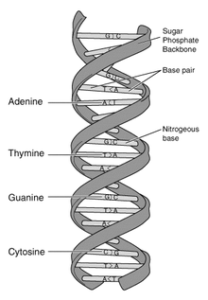 Even though most biologists accept Darwin’s theory of natural selection as the explanation for how modern species came to exist, the mystery remains of how complex multicellular plants and animals evolved from far simpler single-celled organisms that rely on asexual reproduction to perpetuate their species. The offspring of single-celled organisms have the genes and DNA from only one parent, requiring no fusion of gametes or changes in the number of chromosomes.
Even though most biologists accept Darwin’s theory of natural selection as the explanation for how modern species came to exist, the mystery remains of how complex multicellular plants and animals evolved from far simpler single-celled organisms that rely on asexual reproduction to perpetuate their species. The offspring of single-celled organisms have the genes and DNA from only one parent, requiring no fusion of gametes or changes in the number of chromosomes.
Single-celled organisms are independent creatures. The average human body contains anywhere between 60 and 90 trillion cells that cooperate and work in collaboration to function as bones, organs, and tissue. The biological processes and rules that governs the creation of DNA from two parent organisms are far more complex and require the development of new protein structures which single-celled organism neither have nor need and therefore should not be produced by asexual reproduction. However, recent research and experiments have suggested a protein structure named GK-PID facilitated evolution from ancient, ancestral single-celled organisms into more complex and modern creatures and humans.
Christian beliefs regarding the origin of life vary from young earth creationism with an earth only 6,000 years old to old earth creationism, which finds no conflict between the Big Bang theory as the explanation for the origin of the universe and Genesis 1:3, which reads, “And God said, “Let there be light,” and there was light.” Christians may also believe that intelligent design or even theistic evolution best describes how God created the universe. The common denominator in Christian thought is that we know God is responsible for creation, but we may disagree on how God created our universe and the life within.
Scientists must rely on a hypothesis from chemistry called abiogenesis to attempt an explanation for how inanimate matter became alive without any need for divine intervention, using the rationale that no matter how unlikely, the origin of life only had to have happened once. The most successful experiments were conducted by Stanley Miller and Harold Urey in the 1950s and produced a few precursor amino acids, but no living cells, nucleotides or DNA. Still, biologists believe that chemical reactions caused DNA to form and a living cell to be created (which logically must have been a single-celled organism.)
Now the GK-PID molecular carbiner, which binds two partner molecules that work together acting as an anchor and motor combination, has been proposed as an ultimate missing link bridging the gap between single-celled organisms like bacteria, and far more complex creatures like us. Researchers now claim to have sequenced DNA that existed almost a billion years ago and resurrected that DNA in a laboratory in order to perform “molecular time travel” experiments. These experiments allegedly showed how a single, lucky mutation could have caused this ancestral protein to evolve and develop a completely new function that enabled this remarkable transition from single cells into more complex organisms. Because of Darwin’s theory, biologists have assumed that new information can be added by viral insertion into an existing genome and becomes an inherited trait passed down to offspring, eventually culminating in dramatic metamorphosis and a classification as new species. According to current biological rules of sexual reproduction, we know that for mating to result in fertile offspring, both parents must belong to the same species.
http://pulsobeat.com/tag/dj-rat-race/ What is a species?
Biologist’s use of the term species has become alarmingly inconsistent. There is only one classification of species for humans, homo sapiens. This application of the term is perfectly logical, because no matter where two human beings (male and female) were born, should they meet one day and choose to become parents, they should have no difficulty producing fertile offspring that may perpetuate our species. For example, a person from Sweden where blond hair and blue eyes are dominant characteristics could marry someone from Japan, where dark hair and brown eyes are common, and their children will have a somewhat blended physical appearance due to their unique DNA. There is one species for all dogs, canis lupus familiarus.
An ornithologist will more than likely classify a seagull found in the U.K. as a European herring gull, Larus argentatus. The same gull in America will probably be identified as Larus smithsonianus, an American herring gull. Why are there 28 different species of seagulls in North America alone, each with its own unique Latin name? Why is there only one species of domestic dogs, sub classified into breeds, but eight unique species of bears? Even two varieties of the same fruit fly have been classified into separate species, even though hawthorn fly and apple maggot fly are virtually identical in physical appearance. However, the claim that new species have evolved from existing species is actually contradicted by known, easily observed evidence. Two human beings will always give birth to a human child. Two apes will always produce an ape. Even if apes and humans attempted to mate (they can’t because of the different number and configuration of chromosomes) their offspring would be sterile just like mules, zedonks, and other hybrid animals, because they are not the origin of a new species. The offspring would be a biological dead end. It is only by redefining the meaning of species and applying arbitrary rules to the definition can biologists claim to have observed in both laboratory experiments and in the wild the process known as speciation, or the emergence of new species after changes to an existing species become persistent.
Only by adding time to the equation can the advocates of evolution claim, as Darwin himself famously scribbled in his notebook “monkeys make men.” Of course, modern biologists word it somewhat differently, only claiming that humans and apes share a common ancestor. The problem is these same known biological processes: sexual reproduction, isolation of a breeding population, and time are supposed to explain man’s relationship to the turnip as well as the chimpanzee. As biologist and author Richard Dawkins wrote: “Evolution is a fact. Beyond reasonable doubt, beyond serious doubt, beyond sane, informed, intelligent doubt, beyond doubt evolution is a fact. The evidence for evolution is at least as strong as the evidence for the Holocaust, even allowing for eyewitnesses to the Holocaust. It is the plain truth that we are cousins of chimpanzees, somewhat more distant cousins of monkeys, more distant cousins still of aardvarks and manatees, yet more distant cousins of bananas and turnips…continue the list as long as desired.” [1]
http://koolkoncepts.com/ac-repair/ Does GK-PID bridge a significant evolutionary gap?
It is theoretically possible that GK-PID does play the role researchers have claimed allowing the transition from single-celled organisms as these remarkable experiments have suggested, but it should be noted that these tests should actually be considered examples of intelligent design. DNA evidence that is nearly a billion years old does not exist. Computer simulations produced a theoretical sequence for this ancestral organism based on reasonable expectations, but not scientific evidence.
Even so, researchers were able to synthesize this ancestral DNA and inject the results into bacterial and insect cells by experiment, and then observed the development of new molecular function, according to their published results.
Professor of ecology and evolution Joe Thornton, the leader of the project said, “It’s just coincidence that the two molecules look so similar. But that lucky resemblance is why a simple genetic event could cause the evolution of a molecular partnership that is now essential to the biology of complex animals.” [2]
It is interesting to believe that serendipity could have played such an important role in causing our existence, but if evolution can ever be seen as a replacement for creation, good fortune must have played a vital role. In the GK-PID laboratory experiments, researchers worked backwards using the DNA of known species to reconstruct the prehistoric model on which the experiments were based. But that one minor mutation in single-celled organisms is hardly the only amount of luck necessary to believe this universe came to exist without God as the cause. These experiments utilized highly probable pathways for evolution, but the Big Bang and abiogenesis were definitely not probable events. The Big Bang may be considered solid scientific theory, but it depends on multiverse hypotheses, string theories, or an equally unproven Grand Unified Theory. Abiogenesis has yet to graduate from hypothesis to theory. And biologists have exaggerated the significance of certain scientific evidence.
Is the rationale for mainstream atheism based on belief in some unbelievable good luck?
Are hybrid species really out of the question?
Of course, there have been examples of wild speculation attempting to explain how new species might evolve from existing species. In 1940,Richard Goldschmidt proposed that new species could rarely but suddenly result from profound mutations caused by sexual reproduction, referring to them as “hopeful monsters.”
More recently one respected physicist rather ludicrously suggested that chimpanzees might have successfully mated with pigs in the past, producing human hybrids. Other scientists have proposed that increased consumption of fruit was a significant factor in human-to-ape evolution.
These competing theories and hypotheses have one thing in common — apparently people who don’t believe in a supernatural creator God will believe in just about anything else.
[1] Dawkins, Richard. The Greatest Show on Earth: the Evidence for Evolution. Page 8. New York. Free Press. 2009. Print.
[2] Jiang, Kevin. “A single, billion-year-old mutation helped multicellular animals evolve.” Science Life. The University of Chicago Medicine and Biological Sciences. January 7, 2016. Online.

All I see is a primate denying biological evolution by claiming divine origins, how narcissistic can one be?